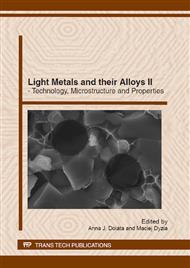p.37
p.45
p.57
p.67
p.75
p.81
p.89
p.101
p.109
Machinability of Aluminium Matrix Composites
Abstract:
The today's interest in MMCp results from a number of their creative properties, which can be designed through a proper selection of reinforcing components and technological parameters. The composite machine elements such us engine, compressor parts obtained by casting methods require the specially final machining. The introduction of hard ceramic particles increase wear resistance of composite material compared to unreinforcement alloy. Simultaneously increase wear and reducing the durability of tools cutting. The presence of ceramic particles (SiC, Cs) in aluminium matrix influence on surface geometry formed in track of processing. In this paper the results of investigations of geometry surface of composite after machining will be presented. Applied machining conditions for composite material were the same as for unreinforcement alloy, it made possible to compare the conditions of machining processing. It the piston skirt was conducted light profilometry investigation were the parameters 2D and 3D surface topography evaluated. Results shows dependency of surface parameters (Ra, Rz) after machining on kind, size and volume fraction of reinforcement particles applied in composite material.
Info:
Periodical:
Pages:
75-80
Citation:
Online since:
August 2012
Authors:
Price:
Сopyright:
© 2012 Trans Tech Publications Ltd. All Rights Reserved
Share:
Citation:


